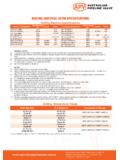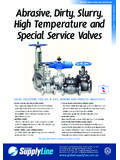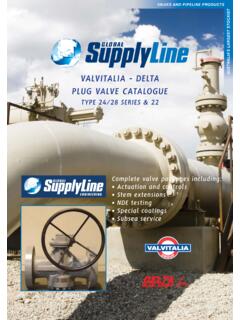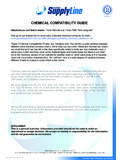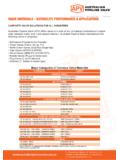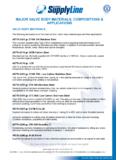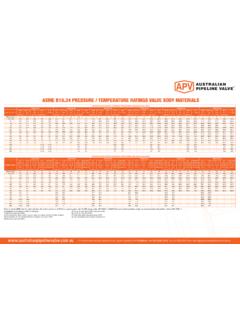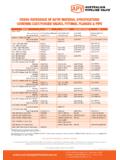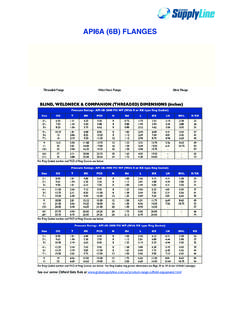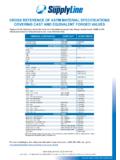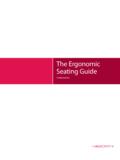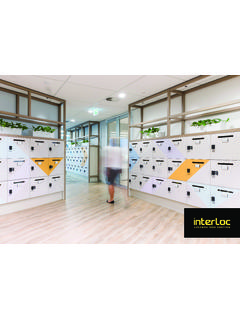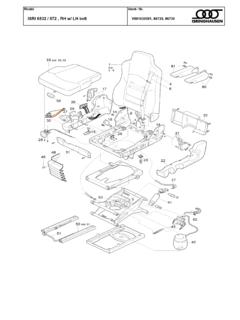Transcription of Valve Seating Types Selection Guide
1 Stanbel Road Salisbury Plain, South Australia 5109 Telephone +61 (0)8 8285 0033 Fax +61 (0)8 8285 BRISBANE PERTHVALVE Seating Types Selection GUIDEVALVE Seating STYLESB efore specifying and selecting isolation valves , for the Seating mechanism, the different Seating styles must be evaluated. There are seven basic categories: -Self Energised SeatingTypically bi-directional and usually double block & bleed capable self energised piston action Seating systems are instantly live loaded with the aid of springs or other mechanical systems to the gate or disc. This style of Valve will seal independent of line pressure at very low pressures, as no line pressure is required to energise the seat.
2 This style of Seating system can also often accommodate thermal expansion better without jamming. Examples include: - Trunnion mounted ball valves which employ springs behind the seat. This style of Valve also utilises line pressures to improve sealing, as well as being able to relieve excess differential pressure in the body cavity, hence this fl oating seat design of Valve also incorporates pressure assigned sealing . Other examples are API6D and API6A through conduit (parallel slide) gate valves which are a available with spring energised seats or expanding split two piece gates that spread as they are closed to energise a seal.
3 Parallel slide gate valves for steam are another example and employ two gates that are mechanically energised by springs or a mechanical wedge spreader mechanism. Soft seated expanding plug valves are yet another FitOnce again this style is typically bi-directional, and usually not double block & bleed capable and will totally seal independently of line pressure at low and high delta P. For example: - - Wedge gate valves (fl exible and solid wedge Types ) - Butterfl y valves (eccentric or centre lined)Essentially, there is a wedging or squeezing (in the case of resilient seat valves ) action that causes an interference to create a seal.
4 Friction fi t also can include resilient seated valves like Tefl on lined or sleeved plug valves and diaphragm valves , that exert mechanical pressure on resilient Seating material like Tefl on or rubber. For lower pressure applications sometimes there may also be a degree of line pressure energising the down stream seat but the friction alone is all that is required for a low pressure Assigned SeatingThis type of Valve actually uses the pressure to assist in sealing the seat, so higher pressure will serve to improve the seal (within the capabilities of the seat material and tolerances) the ball, gate or plug and can therefore be pushed onto the down stream seat by the line pressure.
5 Hence this Valve type is not suitable for double block & bleed applications due to only one seat sealing. This style of Valve also has the disadvantage of not being leak tight at very low pressure or under vacuum. This style can be bi-directional like a fl oating ball Valve as it has upstream and down stream seats. assisted sealing valves don t have the problem of pressure building up in the Valve cavity due to the thermal expansion. Nor do they have the problem of the disc or seat expanding at higher temperatures and sticking. However, as the valves have no trunnion supporting the bottom of the disc they are less suitable for high pressure that can make them hard to turn, and can also exert too much pressure on the stem sealing area, causing API6A fl owing slab through conduit gate valves also use this style (Australian Pipeline Valve offers FC , FL style).
6 Some single seated, uni-directional knife gate, non-lubricated plug valves and single offset high performance butterfl y valves also use this method of sealing. Care should be taken on vertical (upwards) service with these Types of valves as gravity can cause them to act imperfectly, particularly at lower Self Energised & Pressure Assisted SeatingTrunnion mounted ball valves utilise both of the afore mentioned Seating systems. Typically fi tted with self energised fl oating seat retainers with backing springs, the unique standard two way seat retainer design utilises line pressure to further increase the Seating seal. This 2 way seat design also automatically relieves body cavity over-pressure.
7 Once again they are bi-directional, double block & bleed capable and utilise energised Seating systems which are instantly live loaded with the aid of springs behind the valves Metal to metal seated lubricated API6D plug and even some lubricated API6A gate valves utilise the grease to obtain a drip tight seal, in addition to a friction interference fi t. This is not to be confused with other Types of valves that have emergency sealant SeatingThis style of Seating system must be in a fairly acute position to effect a seal. Over closing (which can be avoided with gearbox stops ) is possible, and cheating will move the Valve away from the optimum Seating sweet spot and can even cause excess wear or damage to the Seating area.
8 Many manufacturers like Australian Pipeline Valve have inbuilt stops to ensure this doesn t happen. This style of Valve requires no line pressure to affect the seat. Examples of this style of Seating are double offset (double eccentric) butterfl y valves . This style of Valve has minimal interference during opening or closing and the disc cams closes against the seat. This style of Valve needs to sit right on the closing position, Seating Types Selection Guide - AS Copyright Australian Pipeline Valve 2016unlike a rubber lined butterfl y Valve for instance that has a wider closing tolerance. Some parallel, non energised gate valves can easily be under or over Twin seal wedge plug valves also utilise a combination of cam action, positional Seating action of a plug plus resilient soft seat inserts which provide an oversized seal for bubble tight shut SeatingThis type of Seating system is still positionally seated with an optimum closed position but also requires a certain amount of torque to energise an effective seal.
9 This is because it is often used for higher pressures and/ or metal to metal minimal friction fi t applications that still require a tight shut off without the benefi t of resilient seats or true interference fi ts like wedging action, etc. A typical example of this style of Seating are triple offset (triple eccentric) butterfl y valves . This style of Valve has minimal interference during opening or closing and the disc cams and closes against the seat rather than scraping friction fi t seal. This style of Valve is designed to close tight at a set torque tension. Gear box stops ensure this point cannot be passed. For this reason triple offset butterfl y valves when refi tted with automatic actuators cannot have a safety factor of over 50% as the seats will not function correctly or could be damaged if over tightened.
10 These Types of valves are bi-directional but do have a preferred fl ow direction in which they are drip tight or even bubble tight. The preferred direction also has reduced closing torque against line pressure.
